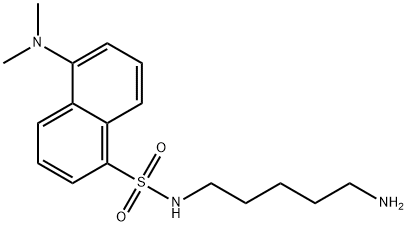10121-91-2
中文名稱
N-(5-氨基戊基)-5-(二甲基氨基)萘-1-磺酰胺
英文名稱
DANSYLCADAVERINE
CAS
10121-91-2
分子式
C17H25N3O2S
分子量
335.46
MOL 文件
10121-91-2.mol
更新日期
2024/11/05 14:42:12
 10121-91-2 結(jié)構(gòu)式
10121-91-2 結(jié)構(gòu)式
基本信息
中文別名
丹酰尸胺丹酰戊二胺
單丹磺酰戊二胺
DANSYL 尸胺
N-丹酰-1,5-戊二胺
N-(5-氨基戊基)-5-(二甲基氨基)萘-1-磺酰胺
N-(5-氨基戊基)-5-(二甲基氨基)萘-1-磺酰胺(丹酰尸胺)
英文別名
5-DANSYLCADAVERINE
MONODANSYL CADAVERINE
MONODANSYLCADAVERINE CRYSTALLINE
DANSYLCADAVERINE, FOR FLUORESCENCE
DANSYLCADAVERINE MONODANSYLCADAVERINE
N-(DIMETHYL-AMINO-NAPHTHA-LENE-SULFONYL)-1
N-(DIMETHYLAMINONAPHTHALENESULFONYL)-1,5-PENTANEDIAMINE
N-(5-AMINOPENTYL)-5-DIMETHYLAMINONAPHTHALENE-1-SULFONAMIDE
所屬類別
有機(jī)原料:氨基化合物物理化學(xué)性質(zhì)
熔點(diǎn)137-140 °C
沸點(diǎn)505.5±60.0 °C(Predicted)
密度1.190±0.06 g/cm3(Predicted)
儲存條件−20°C
溶解度Do you have solubility information on this product that you would like to share
酸度系數(shù)(pKa)11.96±0.50(Predicted)
形態(tài)粉末
顏色黃色至黃綠色
最大波長(λmax)335 nm
BRN2951070
穩(wěn)定性Stable for 1 year from date of purchase as supplied. Solutions in DMSO or methanol may be stored at -20°C for up to 1 month.
生物領(lǐng)域應(yīng)用Measuring cardiac autophagic flux; treating cataract,fibrosis,Parkinson’s disease,peritoneal ovarian tumor dissemination,respiratory diseases,lung diseases,Huntington’s disease,spinobulbar atrophy,spinocerebellar ataxia,denta
安全數(shù)據(jù)
N-(5-氨基戊基)-5-(二甲基氨基)萘-1-磺酰胺價(jià)格(試劑級)
| 報(bào)價(jià)日期 | 產(chǎn)品編號 | 產(chǎn)品名稱 | CAS號 | 包裝 | 價(jià)格 |
| 2024/11/08 | HY-D1027 | N-(5-氨基戊基)-5-(二甲基氨基)萘-1-磺酰胺 Dansylcadaverine | 10121-91-2 | 50mg | 300元 |
| 2024/11/08 | HY-D1027 | N-(5-氨基戊基)-5-(二甲基氨基)萘-1-磺酰胺 Dansylcadaverine | 10121-91-2 | 100 mg | 450元 |
| 2024/04/30 | HY-D1027 | N-(5-氨基戊基)-5-(二甲基氨基)萘-1-磺酰胺 Dansylcadaverine | 10121-91-2 | 10mM * 1mLin DMSO | 330元 |
常見問題列表
生物活性
Dansylcadaverine (Monodansyl cadaverine) 是一種用于標(biāo)記自噬空泡的自熒光化合物。Dansylcadaverine 是谷氨酰胺轉(zhuǎn)胺酶的高親和力底物,能阻斷受體介導(dǎo)的多種配體的內(nèi)吞作用。體外研究
The inhibitory activity of dansylcadaverine reflects its ability to serve as a substrate for transglutaminases and to block competitively the crosslinking of fibrin molecules.
Dansylcadaverine, a cationic fluorescent probe binds to bacterial lipopolysaccharide and lipid A, and is displaced competitively by other compounds which possess affinity toward endotoxins.
